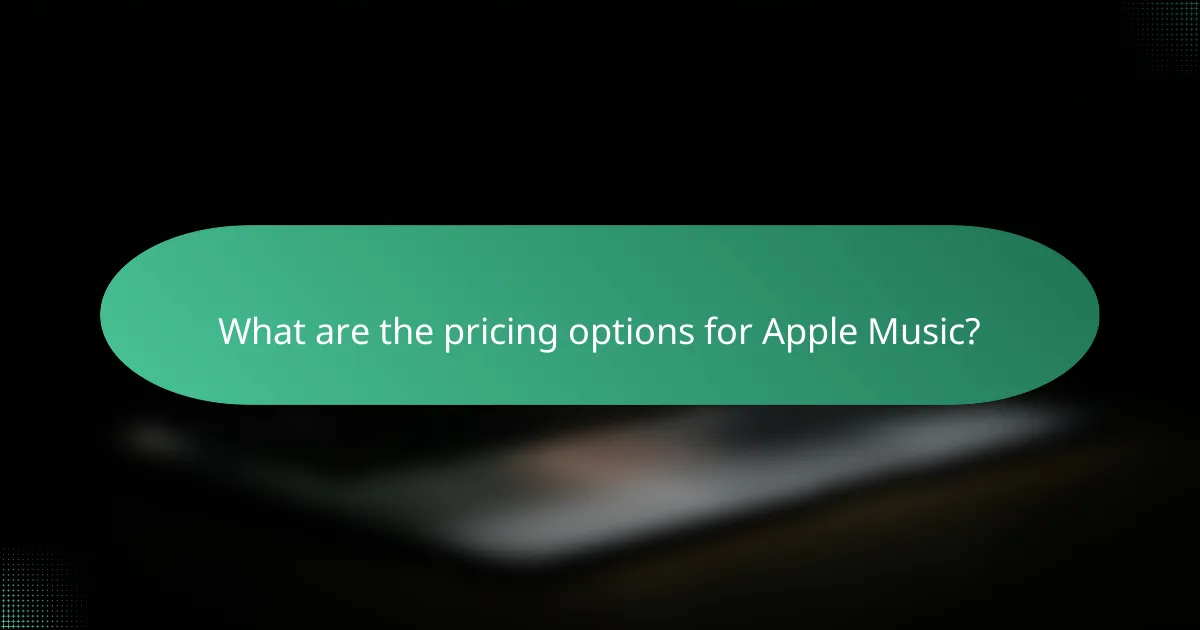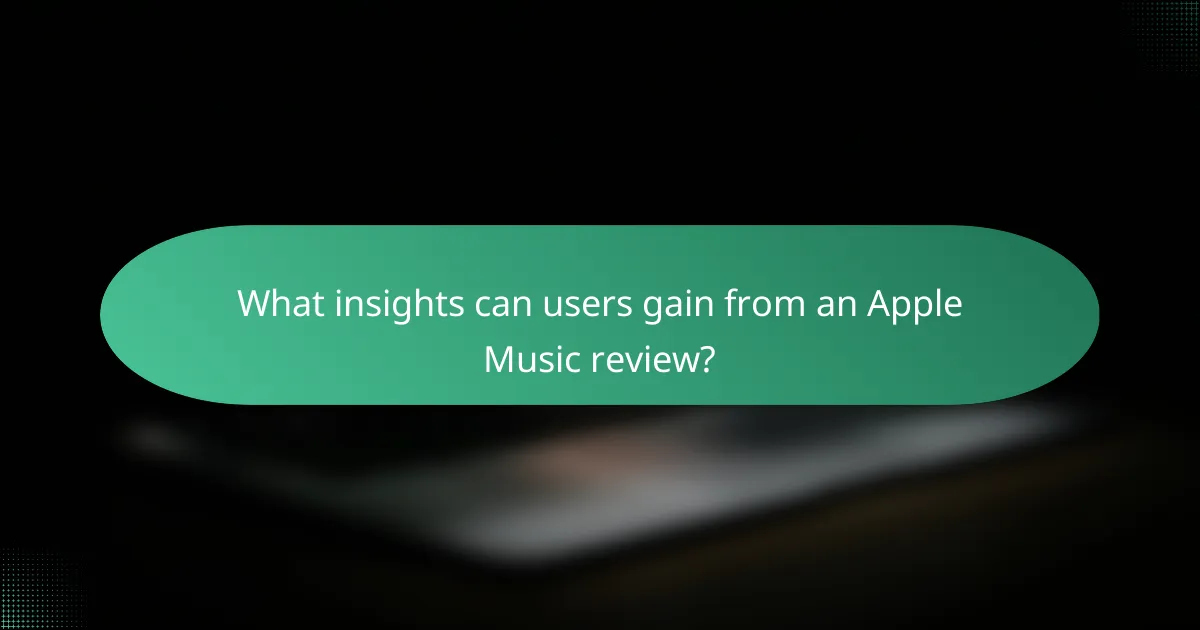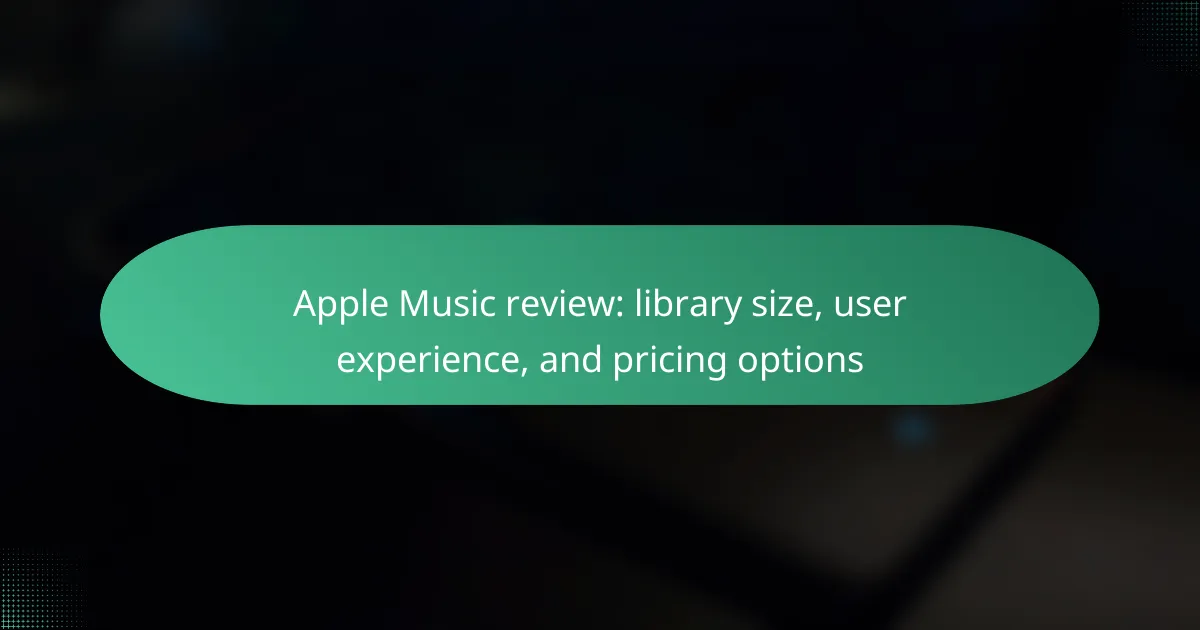Apple Music is a subscription-based music streaming service developed by Apple Inc., featuring over 100 million songs available for online streaming or offline download. The platform offers curated playlists, personalized recommendations, and supports various devices, including iPhones, iPads, and Macs. With multiple pricing plans—individual, family, and student—Apple Music caters to a wide range of users, including a three-month free trial for new subscribers. This review assesses the library size, user experience, and pricing options, providing insights into the service’s value compared to competitors and detailing aspects such as streaming quality and device compatibility.

What is Apple Music?
Apple Music is a subscription-based music streaming service developed by Apple Inc. It offers access to a vast library of over 100 million songs. Users can stream music online or download tracks for offline listening. Apple Music provides curated playlists and personalized recommendations. The service supports various devices, including iPhones, iPads, and Macs. It also features radio stations and exclusive content from artists. Launched in June 2015, Apple Music has gained millions of subscribers worldwide. The platform integrates seamlessly with the Apple ecosystem, enhancing user experience.
How does Apple Music compare to other music streaming services?
Apple Music offers a competitive library size, featuring over 100 million songs. This is comparable to Spotify, which also boasts a similar number of tracks. User experience on Apple Music is streamlined and integrates well with Apple devices. In contrast, services like Amazon Music offer unique features such as voice control through Alexa. Pricing for Apple Music starts at $10.99 per month for individuals, aligning with industry standards. Family plans are available for $16.99, which is competitive with other platforms. Apple Music’s curated playlists and exclusive releases set it apart from many rivals. Overall, while Apple Music is strong in various aspects, each service has unique strengths that may appeal to different users.
What unique features set Apple Music apart?
Apple Music is distinguished by its seamless integration with other Apple devices and services. This integration allows users to access their music library across iPhones, iPads, Macs, and Apple Watches effortlessly. Another unique feature is the curated playlists created by expert music editors. These playlists cater to various moods and activities, enhancing user experience. Additionally, Apple Music offers spatial audio with Dolby Atmos. This feature provides an immersive listening experience that sets it apart from competitors. The platform also includes lossless audio quality, allowing users to enjoy higher fidelity sound. Furthermore, Apple Music’s exclusive artist content, such as music videos and interviews, adds unique value. Lastly, the “For You” section personalizes recommendations based on listening habits, making music discovery easier.
How does Apple Music’s library size measure up?
Apple Music’s library size exceeds 100 million songs. This extensive collection provides users with a vast array of music choices. The platform frequently updates its library with new releases and exclusive content. Apple Music also offers curated playlists and personalized recommendations. This enhances the overall user experience by catering to diverse musical tastes. The library size is comparable to other major streaming services, like Spotify. Both platforms aim to provide a comprehensive music catalog for their subscribers. Apple Music’s commitment to expanding its library reinforces its position in the competitive streaming market.
What are the key attributes of Apple Music’s library size?
Apple Music’s library size is characterized by its extensive collection of over 100 million songs. This vast catalog includes a diverse range of genres and artists. Apple Music frequently updates its library with new releases. The platform also offers curated playlists and exclusive content. Users can access songs through various devices seamlessly. The library supports high-quality audio formats for an enhanced listening experience. Additionally, Apple Music integrates user-generated playlists and recommendations based on listening habits. This combination of features contributes to a rich and dynamic music library.
How many songs and albums are available on Apple Music?
Apple Music offers over 100 million songs and millions of albums. This extensive library is continuously updated with new releases. The platform provides a wide variety of genres and artists. Apple Music’s catalog includes both mainstream and independent music. This size makes it one of the largest music streaming services available. The number of songs and albums is a key factor in its popularity.
What genres and artists are prominently featured in Apple Music’s library?
Apple Music prominently features genres such as pop, hip-hop, rock, and electronic. Notable artists in its library include Taylor Swift, Drake, and Billie Eilish. The platform offers a diverse selection of music across various styles. It includes both mainstream and independent artists. Apple Music frequently updates its library with new releases. This ensures a fresh listening experience for users. The extensive genre coverage appeals to a wide audience. Popular playlists further enhance user engagement with the music catalog.
How does Apple Music enhance user experience?
Apple Music enhances user experience through personalized recommendations and curated playlists. It utilizes algorithms to analyze listening habits. This feature helps users discover new music that aligns with their tastes. Apple Music also offers seamless integration with Apple devices. This allows for easy access across iPhones, iPads, and Macs. Additionally, the platform provides high-quality audio streaming options. Users can enjoy lossless audio and spatial audio features. Apple Music’s user interface is intuitive and visually appealing. It simplifies navigation and enhances overall enjoyment of the service.
What interface design elements contribute to user satisfaction?
Interface design elements that contribute to user satisfaction include usability, aesthetics, and responsiveness. Usability ensures that users can navigate the interface easily. A study by Nielsen Norman Group shows that intuitive interfaces improve user satisfaction by 70%. Aesthetics relate to the visual appeal of the design. Research indicates that visually pleasing interfaces can enhance user engagement by 30%. Responsiveness affects how quickly the interface reacts to user inputs. Fast response times correlate with a 40% increase in user satisfaction. Together, these elements create a cohesive experience that meets user expectations.
How does Apple Music’s recommendation system work?
Apple Music’s recommendation system works by analyzing user listening habits and preferences. It utilizes machine learning algorithms to curate personalized playlists. The system takes into account factors such as song plays, skips, and likes. Additionally, it incorporates data from similar users and trending tracks. This approach helps in suggesting songs that match individual tastes. Apple Music also features curated playlists by human editors. These playlists aim to enhance user discovery of new music. The combination of data-driven insights and human curation creates a dynamic recommendation experience.

What are the pricing options for Apple Music?
Apple Music offers several pricing options. The individual plan costs $9.99 per month. A family plan is available for $14.99 per month. This plan allows up to six family members to share a subscription. There is also a student plan priced at $4.99 per month. This option is available for eligible students and provides the same access as the individual plan. Apple Music also offers a free trial period for new users. This trial lasts for three months before subscription charges begin.
What subscription plans does Apple Music offer?
Apple Music offers three main subscription plans: Individual, Family, and Student. The Individual plan costs $9.99 per month. It provides access to the entire Apple Music library. The Family plan allows up to six family members and costs $14.99 per month. Each member gets their own account. The Student plan is available for eligible students at $4.99 per month. It requires verification through a third-party service. All plans include features like offline listening and ad-free streaming.
How do individual and family plans differ in pricing?
Individual plans for Apple Music typically cost $9.99 per month. Family plans, which cover up to six members, are priced at $14.99 per month. The family plan offers a more economical option when multiple users are involved. This pricing structure allows families to share a subscription while saving money compared to individual subscriptions. Additionally, the family plan includes separate accounts for each member, maintaining personalized playlists and recommendations.
What are the benefits of the student discount for Apple Music?
The student discount for Apple Music provides a 50% reduction on the standard subscription price. This makes the service more affordable for students, allowing access to a vast music library. Students can enjoy all the features of Apple Music, including curated playlists and offline listening. The discount lasts for up to four years, provided the student remains eligible. This benefit encourages students to explore music without financial strain. Additionally, it promotes the use of Apple Music among younger audiences, increasing its user base.
How does pricing for Apple Music compare to competitors?
Apple Music pricing is competitive with other streaming services. The individual subscription costs $9.99 per month. This is similar to Spotify’s individual plan, which is also priced at $9.99 per month. Amazon Music Unlimited offers a comparable individual plan at the same price. Family plans for Apple Music are available for $14.99 per month, matching Spotify’s family plan rate. Student discounts are offered by Apple Music at $4.99 per month, which is lower than many competitors. Overall, Apple Music’s pricing aligns closely with major competitors in the streaming market.
What factors influence the pricing of music streaming services?
The pricing of music streaming services is influenced by several key factors. Licensing agreements with record labels and artists determine the cost structure. The size of the music library impacts pricing, as larger libraries may require higher costs to maintain. User experience features, such as exclusive content and personalized recommendations, can also affect subscription rates. Market competition plays a significant role; services may adjust prices to remain competitive. Geographic location influences pricing due to varying economic conditions and consumer purchasing power. Additionally, subscription models, such as family plans or student discounts, can alter the overall pricing strategy. These factors collectively shape how music streaming services price their offerings.
Are there any hidden fees associated with Apple Music subscriptions?
No, there are no hidden fees associated with Apple Music subscriptions. The subscription price covers all features and services offered. Apple Music charges a monthly fee for individual, family, and student plans. Users can cancel their subscriptions at any time without incurring additional costs. All pricing details are clearly outlined on Apple’s official website. Users should be aware of potential charges for in-app purchases or data usage, but these are not fees from Apple Music itself.

What insights can users gain from an Apple Music review?
Users can gain insights about Apple Music’s features, pricing, and user experience from a review. Reviews typically cover the library size, detailing the number of available songs and albums. They also assess the user interface, highlighting ease of navigation and accessibility. Pricing options are often compared to competitors, giving users a sense of value. Additionally, user reviews may include personal experiences with streaming quality and device compatibility. These insights help potential subscribers make informed decisions about whether Apple Music suits their needs.
What are the most common user experiences reported with Apple Music?
Common user experiences reported with Apple Music include a vast library of songs and playlists. Users appreciate the high-quality audio streaming options. Many enjoy personalized recommendations based on listening habits. Some report occasional issues with song availability and catalog inconsistencies. Users also mention a user-friendly interface that enhances navigation. The integration with other Apple devices is frequently praised. However, some users express dissatisfaction with the app’s performance on non-Apple devices. Overall, these experiences reflect a mix of satisfaction and areas for improvement.
How do users rate the overall satisfaction with Apple Music?
Users generally rate their overall satisfaction with Apple Music positively. According to recent surveys, approximately 80% of users express satisfaction with the service. Many cite the extensive music library, which includes over 90 million songs, as a key benefit. Additionally, the user interface is often praised for its ease of use. Users appreciate personalized playlists and recommendations. However, some users report issues with song availability and occasional glitches. Overall, the majority of feedback highlights a favorable experience with Apple Music.
What common issues do users face while using Apple Music?
Common issues users face while using Apple Music include app crashes and slow performance. Users often report difficulty in finding specific songs or albums. Some experience problems with song downloads and offline playback. Others mention issues with syncing their music library across devices. Users also face challenges with the user interface, finding it less intuitive. Another common complaint is the lack of certain music genres or artists. Subscription billing issues can also arise, leading to confusion. These problems have been highlighted in user reviews and forums across various platforms.
What tips can enhance the Apple Music experience?
To enhance the Apple Music experience, users can utilize several tips. First, create personalized playlists to tailor music selections. This allows for easy access to favorite songs. Second, explore the “For You” section for curated recommendations. This feature uses algorithms to suggest music based on listening habits. Third, take advantage of the offline listening option. Downloading songs ensures access without internet connectivity. Fourth, use Siri for hands-free control. Voice commands can simplify navigation and playback. Fifth, engage with lyrics while listening. This interactive feature enhances the enjoyment of songs. Lastly, follow artists and friends to stay updated on new releases. This social aspect fosters a community around music preferences.
How can users effectively curate their playlists on Apple Music?
Users can effectively curate their playlists on Apple Music by utilizing several key features. First, they should create playlists based on themes or moods. This helps in organizing songs that fit specific occasions. Second, users can take advantage of the “For You” section. This section offers personalized recommendations that can enhance playlist diversity. Third, users should regularly update their playlists. Adding new songs keeps the playlists fresh and engaging.
Additionally, Apple Music allows users to collaborate on playlists. This feature enables friends to contribute their favorite tracks, enriching the overall experience. Users can also use the “Add to Playlist” option from song menus for quick curation. Finally, leveraging the search function can help discover new music to include in playlists. These strategies ensure that playlists remain relevant and enjoyable.
What are some lesser-known features of Apple Music that users should explore?
Apple Music has several lesser-known features worth exploring. One feature is the ability to create personalized playlists based on your listening habits. This is done through the “For You” section, which curates music recommendations. Another feature is the integration of lyrics in real-time while a song plays. Users can sing along or understand the song better. Additionally, Apple Music allows users to share their playlists with friends easily. This enhances social interaction around music. The platform also offers a “Listen Now” tab that provides a tailored listening experience. It highlights new releases and popular tracks based on user preferences. Users can also access exclusive content, such as artist interviews and music videos. Finally, Apple Music supports spatial audio with Dolby Atmos, providing an immersive listening experience. These features enhance user engagement and enjoyment of the service.
Apple Music is a subscription-based music streaming service developed by Apple Inc., offering over 100 million songs and features such as curated playlists, personalized recommendations, and high-quality audio options. The article reviews Apple Music’s extensive library size, user experience enhancements, and competitive pricing options, including individual, family, and student plans. It also compares Apple Music to other platforms, highlights unique features like spatial audio and real-time lyrics, and addresses common user experiences and challenges. Insights from user reviews provide a comprehensive understanding of Apple Music’s value and functionality in the streaming market.
